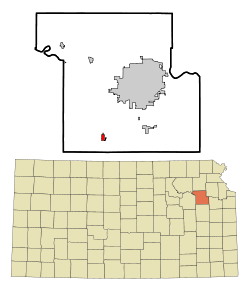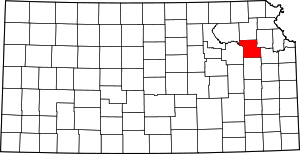Auburn, Kansas
Auburn is a city in Shawnee County, Kansas, United States. As of the 2010 census, the city population was 1,227.[5]
Auburn, Kansas | |
|---|---|
Downtown Auburn (2008) | |
 Location within Shawnee County and Kansas | |
 KDOT map of Shawnee County (legend) | |
| Coordinates: 38°54′24″N 95°49′0″W | |
| Country | United States |
| State | Kansas |
| County | Shawnee |
| Incorporated | 1963 |
| Area | |
| • Total | 0.70 sq mi (1.81 km2) |
| • Land | 0.70 sq mi (1.80 km2) |
| • Water | 0.00 sq mi (0.01 km2) |
| Elevation | 1,083 ft (330 m) |
| Population | |
| • Total | 1,227 |
| • Estimate (2019)[3] | 1,211 |
| • Density | 1,739.94/sq mi (671.72/km2) |
| Time zone | UTC-6 (CST) |
| • Summer (DST) | UTC-5 (CDT) |
| ZIP code | 66402 |
| Area code | 785 |
| FIPS code | 20-03250 |
| GNIS ID | 0479054[4] |
| Website | auburnks.com |
History
19th century
In July 1854, John W. Brown came to this area and found it highly suitable for a homestead. He acquired 800 acres (3.2 km2) through bartering with local Indians. He later returned home to Missouri to tell his family and friends about the area. Some returned with him. In 1856, Mr. Brown along with M. C. Dickey, Loring Farnsworth and Henry Fox pre-empted 320 acres (1.3 km2) for the purpose of a town. They christened it Brownville, although it was changed in 1857 to present name "Auburn" due to the fact there was another settlement with the same name. This was before the introduction of postal codes. It was located on the California Road and work began at once on the many buildings needed in a town of Brownville's size. Two daily stage lines brought mail and people to the town and business was very good.
Robert Simmerwell was a missionary to the Indians in Auburn. He originally served as a missionary among the Pottawatomie Indians in Michigan Territory, while he apprenticed to a blacksmith and attended school at night. He later came to the Baptist Shawnee Mission on Pottawatomie Creek in eastern Kansas. In 1848 the government set up a new mission a few miles west of Topeka. In a three-story stone building with twelve rooms, boys and girls were given instruction in the manual arts, as well as in reading, writing, arithmetic, and religious subjects. In the fall of 1854, he and his wife had retired from active work in the Pottawatomie Mission, to homestead on 160 acres (0.6 km2)southwest of the town.
In the 1850s, the city grew fast, and was often referred to as a "boom town". It was one of the largest in the state, and nearly became the state capital. However, Auburn was cast aside as an option, as the railroad bypassed the city. Topeka was chosen to be the capital because it had the railroad and an important ferry site along the Kansas River. The population dwindled, but continued to hover around 100 for many decades.
20th century
A description of the town from a 1912 volume of Kansas: A Cyclopedia of State History is as follows:
Auburn, a money order post office of Shawnee county, is in the township of the same name, about 15 miles (24 km) southwest of Topeka and 8 miles (13 km) west of Wakarusa, which is the nearest railroad station. It is a trading center for that section of the county, has Baptist, Methodist and Presbyterian churches, telephone connection with Topeka and other adjacent points, and in 1910 reported a population of 72. Two rural free delivery routes start from the Auburn office and supply daily mail to the farmers of the vicinity.
Auburn finally began to grow in population in the 1950s. An important issue at this time was the city's small school system. It consisted of Auburn Grade School (grades K-5) and Auburn High School (grades 6-12). The Highschool was quickly becoming overcrowded. It was eventually decided that the Auburn School district would merge with the Washburn School District to increase efficiency. The last class graduated from Auburn High in 1966. The high school was razed to construct Auburn Middle School, and in 1990 this school closed and was converted to a community center, and the grade school remains open to this day.
In the 1960s and 1970s, the city's population shrank, but was re-vitalized with large housing projects. Between 1975 and 1985, roughly 100 new split-level homes were built.
21st century
The city itself contains several businesses. There is a BP gas station, a dentist, a veterinary clinic, a chiropractor, a pizza restaurant, a liquor store, a Dollar General (which opened in late 2009), and a premium used car dealership as well as others. Most Auburn residents commute to other surrounding cities for work, often Topeka. Currently, there are three churches in Auburn: Presbyterian, Christian, and Methodist. The Auburn Community Center houses a community library. Many people in Auburn also belong to groups such as the Auburn Lions Club, the Auburn Volunteers Association, the Boy Scouts of America, and the Auburn Ball Association. Rental space for meetings/activities is available at the Auburn Civic Center and the Auburn Community Center (former high school).
Auburn has a full-time police department with two patrol cars, and a fully equipped volunteer fire department (Shawnee County Fire No. 2).[6] There is also a road maintenance and utilities department.[7]
Geography
Auburn is located at 38°54′24″N 95°49′0″W (38.906709, -95.816789).[8] According to the United States Census Bureau, the city has a total area of 0.64 square miles (1.66 km2), all of it land.[9]
Climate
The climate in this area is characterized by hot, humid summers and generally mild to cool winters. According to the Köppen Climate Classification system, Auburn has a humid subtropical climate, abbreviated "Cfa" on climate maps.[10]
Demographics
| Historical population | |||
|---|---|---|---|
| Census | Pop. | %± | |
| 1880 | 100 | — | |
| 1970 | 261 | — | |
| 1980 | 890 | 241.0% | |
| 1990 | 908 | 2.0% | |
| 2000 | 1,121 | 23.5% | |
| 2010 | 1,227 | 9.5% | |
| Est. 2019 | 1,211 | [3] | −1.3% |
| U.S. Decennial Census[11] | |||
Auburn is part of the Topeka, Kansas Metropolitan Statistical Area.
2010 census
As of the census[2] of 2010, there were 1,227 people, 467 households, and 320 families residing in the city. The population density was 1,917.2 inhabitants per square mile (740.2/km2). There were 492 housing units at an average density of 768.8 per square mile (296.8/km2). The racial makeup of the city was 94.6% White, 0.6% African American, 0.4% Native American, 0.2% Asian, 0.1% Pacific Islander, 0.2% from other races, and 3.8% from two or more races. Hispanic or Latino of any race were 4.1% of the population.
There were 467 households, of which 42.2% had children under the age of 18 living with them, 49.3% were married couples living together, 13.9% had a female householder with no husband present, 5.4% had a male householder with no wife present, and 31.5% were non-families. 28.9% of all households were made up of individuals, and 14.6% had someone living alone who was 65 years of age or older. The average household size was 2.63 and the average family size was 3.28.
The median age in the city was 33 years. 32.4% of residents were under the age of 18; 7% were between the ages of 18 and 24; 26.5% were from 25 to 44; 22.5% were from 45 to 64; and 11.5% were 65 years of age or older. The gender makeup of the city was 47.6% male and 52.4% female.
2000 census
As of the census of 2000, there were 1,121 people, 385 households, and 301 families residing in the city. The population density was 1,920.5 people per square mile (746.2/km2). There were 400 housing units at an average density of 685.3 per square mile (266.3/km2). The racial makeup of the city was 95.63% White, 0.18% African American, 0.89% Native American, 0.36% Asian, 0.36% from other races, and 2.59% from two or more races. Hispanic or Latino of any race were 3.84% of the population.
There were 385 households, out of which 50.4% had children under the age of 18 living with them, 62.6% were married couples living together, 12.7% had a female householder with no husband present, and 21.6% were non-families. 17.7% of all households were made up of individuals, and 8.8% had someone living alone who was 65 years of age or older. The average household size was 2.91 and the average family size was 3.34.
In the city, the population was spread out, with 34.8% under the age of 18, 7.9% from 18 to 24, 31.9% from 25 to 44, 17.3% from 45 to 64, and 8.1% who were 65 years of age or older. The median age was 30 years. For every 100 females, there were 90.6 males. For every 100 females age 18 and over, there were 84.1 males.
The median income for a household in the city was $42,632, and the median income for a family was $44,934. Males had a median income of $31,699 versus $22,222 for females. The per capita income for the city was $15,679. About 2.3% of families and 3.4% of the population were below the poverty line, including 3.9% of those under age 18 and 4.5% of those age 65 or over.
In popular culture
Auburn is the hometown of Cameron Mitchell, a fictional character in the science fiction television series Stargate SG-1, though, the episode showed Auburn as having a population of 21,211.
Notable person
- Nina E. Allender, artist and women's suffrage activist
References
- "2019 U.S. Gazetteer Files". United States Census Bureau. Retrieved July 24, 2020.
- "U.S. Census website". United States Census Bureau. Retrieved 2012-07-06.
- "Population and Housing Unit Estimates". United States Census Bureau. May 24, 2020. Retrieved May 27, 2020.
- "US Board on Geographic Names". United States Geological Survey. 2007-10-25. Retrieved 2008-01-31.
- "2010 City Population and Housing Occupancy Status". U.S. Census Bureau. Retrieved February 18, 2012.
- "Auburn Police Department". Auburn Kansas. Retrieved 19 February 2018.
- "City of Auburn Utilities". Auburn Kansas. Retrieved 19 February 2018.
- "US Gazetteer files: 2010, 2000, and 1990". United States Census Bureau. 2011-02-12. Retrieved 2011-04-23.
- "US Gazetteer files 2010". United States Census Bureau. Archived from the original on January 12, 2012. Retrieved 2012-07-06.
- Climate Summary for Auburn, Kansas
- "U.S. Decennial Census". Census.gov. Retrieved June 7, 2013.
External links
| Wikimedia Commons has media related to Auburn, Kansas. |
- City
- Schools
- USD 437, local school district
- Maps
- Auburn City Map, KDOT
